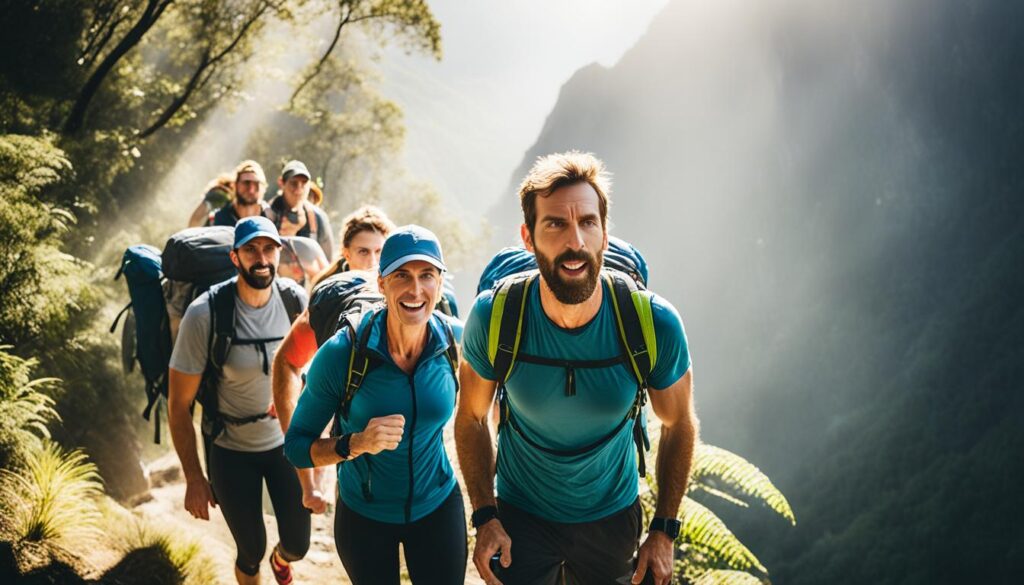Did you know that 4-6 months of prep can change how you tackle the Inca Trail to Machu Picchu? This guide is for everyone, from seasoned hikers to beginners. It offers the key tips and training plan to get you ready for this famous hike. You’ll learn how to boost your heart health, strengthen your legs and core, and get used to hiking with your gear. Plus, we’ll cover how to prepare your mind for the adventure ahead.
Key Takeaways
- Start training for the Inca Trail at least 4-6 months in advance
- Gradually increase your workout frequency from 3 to 5 days per week
- Incorporate cardio, strength training, and stability exercises to prepare your body
- Practice hiking with your gear to get accustomed to the demands of the trail
- Develop mental endurance to push through the physical and mental challenges
Introduction to Training for the Inca Trail
Trekking the Inca Trail to Machu Picchu is an adventure you’ll always remember. It’s 26 miles/42 km long and takes about 4 days and 3 nights to finish. To make it through, you need to train both your body and mind well before you start.
Getting Physically and Mentally Prepared for the Inca Trail
The Inca Trail is considered a moderate hike. You should be pretty fit and ready for high altitudes. Walking 6-8 hours a day at up to 4,200 meters high needs good heart health, strong muscles, and a strong mind. Getting ready early helps you enjoy the journey, not just get through it.
Importance of Training Months in Advance
It’s wise to start training 4-6 months early to get ready for the Inca Trail. The Peruvian government limits permits to 500 people a day, including hikers and support staff. This shows how important it is to be fully prepared, as spots are very sought after.
“The Inca Trail reaches an elevation high point of 4200m (13780ft) and involves two high passes during one long day of ~16km trekking.”
With enough time for physical and mental training, you’ll be ready to tackle the Inca Trail. You’ll be confident, resilient, and able to fully enjoy the stunning views.
| Inca Trail Trek Details | Fact |
|---|---|
| Length of the Classic Inca Trail | 26 miles/42 km |
| Duration of the Classic Inca Trail | 4 days and 3 nights |
| Maximum Weight Limit for Porters | 25 kg, with ethical companies capping it at 20 kg |
| Recommended Group Size for Inca Trail Tours | Around 14 hikers |
| Typical Inclusions for Inca Trail Tours | Inca Trail permit, Machu Picchu entry ticket, transport, accommodation, meals, porters, guides, first aid kit, and more |
| Inca Trail Difficulty Level | Moderate, requiring reasonable fitness and altitude preparation |
| Distance and Elevation Gain on Day 1 | 11 km/6.8 miles, with an elevation gain of 350 m/1,150 feet |
Cardio Training for the Inca Trail
Building a strong heart is key to making it through the Inca Trail. You’ll climb almost 4000m high, with Dead Woman’s Pass being the toughest part. To get ready, focus on exercises that make your heart beat faster, like walking, running, cycling, and swimming.
Aerobic Exercises and Cardiovascular System
Doing aerobic activities boosts how well your body uses oxygen, which is vital for high-altitude trekking. Try to do 3-5 cardio workouts each week. Increase how long and hard you work out over time before your trip. This will build your stamina and get your heart ready for the Inca Trail’s challenges.
Recommended Cardio Activities: Walking, Running, Cycling, Swimming
- Walking: Walking quickly, either outside or on a treadmill, is a top choice for getting fit.
- Running: Adding running to your routine will boost your stamina and how well you use oxygen.
- Cycling: Cycling, whether on a bike indoors or outside, is easy on your joints and great for your heart health.
- Swimming: Swimming is a no-weight-bearing exercise that’s perfect for training and staying fit.
The Inca Trail is over 26 miles (42km) long, spread over four days, with about 7-10 miles (11-16km) each day. Regular cardio workouts will help you tackle the hike’s tough parts.

“The Inca Trail covers a distance of approximately 26 miles over four days, making aerobic exercise key to prepare properly for this hike.”
Strength Training: Legs and Upper Body
To conquer the Inca Trail, you need to focus on strength training for your legs and upper body. Building endurance and stamina is key to tackling the trail’s challenges. Start by running or using a treadmill. Mix in cycling and stair climbing to boost your endurance and heart health. For your upper body, do push-ups, pull-ups, and shoulder presses to get ready for the steep parts.
Leg Exercises
Lunges, squats, and planks work on your quads, hamstrings, calves, and glutes. These exercises improve your stability and endurance. They help you handle the tough steps and ups and downs of the Inca Trail. Adding step aerobics is also great for building leg strength and stamina.
Upper Body Exercises
Work on your core, shoulders, and back with exercises like shoulder presses, back and shoulder flies, and core-focused moves. These exercises help you carry your backpack and keep a good posture on the hike.
Do 2-3 strength training sessions a week, using lighter weights and more reps for endurance. Keep upping the intensity and workout time as you get fitter.
“Strength training is essential for tackling the challenging Inca Trail. Focus on exercises that build endurance and stability in your legs and upper body.”
The hike to Machu Picchu covers about 30 miles over 4 days, starting at 9,000 feet and reaching almost 14,000 feet at Dead Woman’s Pass. You can only carry 7 kg (about 15 lbs.) of weight. Strength training helps you handle the hike’s physical demands.
Practice Hiking with Gear
Getting ready for the Inca Trail is more than just getting fit. It’s key to hike with the same gear you’ll use, like your backpack and hiking boots. This helps you spot any problems or discomfort early. So, you can fix them before you start the real trek.
Importance of Hiking in Similar Terrain and Elevation
Find hiking spots that are as tough as the Andes’ steep, rocky paths. Increase the length and height of your hikes to build up your endurance and strength for the Inca Trail. This prepares your body and gets you used to high altitudes.
Breaking in Hiking Boots and Carrying a Backpack
It’s crucial to break in your hiking boots before the trek to avoid foot problems. Try at least two long hikes (10+ km) with a heavy backpack before going to Peru. This gets you used to your gear’s weight and balance, making the Inca Trail more comfortable and confident.
| Gear Recommendations | Suggested Items |
|---|---|
| Hiking Gear |
|
| Personal Items |
|
Remember, being well-prepared is key to a successful Inca Trail trek. By practicing with your gear, you’re on your way to tackling the Andes and reaching Machu Picchu.

How to Train for hiking Machu Picchu
To prepare for the Inca Trail to Machu Picchu, you need a structured plan. This plan should increase your workout intensity and duration over several months. This gradual increase helps your body get ready for the tough terrain and high altitude of the trek.
Gradually Increasing Workout Intensity and Duration
Start with 3 sessions a week, focusing on cardio and light strength training. As your trek gets closer, increase to 4-5 sessions a week. Include more challenging hikes with big elevation gains. Aim for 3-4 mile hikes at first, then move to 6-8 miles with over 1,000 feet of elevation change. Being consistent and gradually increasing your workouts is key to being ready for the Inca Trail.
Sample Training Regimen for Months Leading Up to the Trek
Do moderate cardio 3-4 times a week, like running a 5k-10k. Begin with short walks, 10 to 15 minutes, and increase the time as you get fitter. Strength training is crucial, focusing on exercises that work your legs and core for carrying a day pack.
The Inca trail is over 26 miles long, with varied terrains. You’ll walk 7-10 miles each day, not always on flat ground. The highest point, Dead Woman’s Pass, is almost 4,000 meters high. Altitude sickness at Machu Picchu can cause headaches, nausea, and serious problems. Training helps avoid these risks and get used to high altitudes.
Adjust your training based on your fitness level – Beginner (4-6 months), Intermediate (3-4 months), Advanced (at least a month). It’s important to get used to high altitude by spending time in Cusco before the trek.
Hiking is a great way to train, especially for uneven terrains. Focus on preparing for tough trails or stairs. Doing muscle-strengthening exercises helps with long walks. Make sure you have the right clothes, shoes, and gear for a successful hike.
Strength training helps your legs and core for hiking. Cardio training improves how well you use oxygen at high altitudes, doing at least 30 minutes daily. Flexibility and balance exercises help with muscle recovery and reduce injury risks, important for hiking on rough ground.
Getting mentally prepared is key, focusing on positive thoughts and mantras to overcome challenges. Mental preparation is vital for Machu Picchu, helping you succeed by visualizing success, being mindful, and using positive affirmations.
Altitude Acclimation and Hydration Strategies
Hiking the Inca Trail is thrilling but comes with high-altitude challenges. The trail goes over 13,800 feet, which can cause altitude sickness if not handled right. Places like Cusco and Machu Picchu, above 8,000 feet, have less oxygen due to lower air pressure.
It’s key to get to Cusco a few days early to let your body adjust to the altitude. Training at higher altitudes helps your body get used to it, lowering the risk of altitude problems. Drinking lots of water and herbal teas is important, as dehydration is common high up. And, avoid alcohol as it can make altitude sickness worse.
- Do breathing exercises and take rest days to help your body get used to the thin air.
- Sorojchi pills, with aspirin, salophen, and caffeine, help fight altitude sickness.
- Coca tea is a traditional fix for altitude sickness, boosting oxygen flow and acting as a mild stimulant.
Always talk to a doctor before starting new meds, especially if you have health issues or take other drugs. These steps will help your body handle the Inca Trail’s demands and let you enjoy the stunning views without altitude sickness.
Mental Preparation and Endurance Training
Completing the Inca Trail is not just about being physically fit. You also need strong mental strength. To make it through, you must build your mental toughness to overcome tiredness and discomfort.
Building Mental Stamina for Challenging Hikes
Set goals for your workouts that are tough but reachable. Then, push yourself to go beyond what you feel like doing. Using visualization, positive thoughts, and stress management can help you build the mental strength needed for this tough hike.
Pushing Past Physical and Mental Limits
The Inca Trail will test you, both in body and mind. To get ready, do exercises that push your endurance and mental strength. Try high-intensity workouts, long hikes with a heavy backpack, and breathing exercises to boost your performance at high altitudes.
Remember, getting to Machu Picchu is a big mental challenge too. By focusing on your mental preparation and building your endurance, you’ll be ready to overcome any hurdles and reach the top of this famous trail.
“The mind is the limit. As long as the mind can envision the fact that you can do something, you can do it, as long as you really believe 100 percent.” – Arnold Schwarzenegger
Trail Safety and Gear Essentials
Being safe on the Inca Trailtrail safety> means having the right hiking gear and suppliesgear essentials> and knowing what to do. Make sure you have good hiking boots, clothes that keep moisture away, trekking poles, and other key items. It’s also important to know about altitude sicknesstrekking> and how to handle it. Bringing enough supplies, drinking plenty of water, and taking breaks are key to staying safe while high-altitude trekkingtrekking>.
Importance of Proper Hiking Gear and Supplies
When you’re heading to Machu Picchu, packing the right hiking gear and suppliesgear essentials> is a must. Peru Rail and Inca Rail have rules about what you can bring, like only one backpack or bag. Make sure your daypack fits these rules for a comfy and safe trip. Also, some things like food and kitchenware are not allowed in your daypack, so check the rules.
Safety Precautions for High-Altitude Trekking
Trekking to Machu Picchu means you need to take extra steps to stay safe. Spending a few days in Cusco before the Inca Trail can help your body adjust to the high altitude. Hiking around Cusco before the main trek is also a good idea to get your body ready. Drinking water and eating enough calories are key to keeping your energy up during the trek.
With the right hiking geargear essentials> and safety steps, you can have a safe and fun Inca Trailtrail safety> trip.
Conclusion
Hiking the Inca Trail to Machu Picchu is a journey you’ll never forget. It’s important to prepare well to make the most of it. Start a training plan that boosts your heart health, muscle strength, and mental strength. This will help you finish the 4-day hike and see the ancient Inca ruins. Don’t forget to get used to the high altitude, pack the right gear, and keep safety first. With the right training and attitude, you’re set to achieve your dream of reaching Machu Picchu.
The Inca Trail is part of the vast Qhapac Ñan network, stretching over 30,000 km across South America. Get ready for the trek with a detailed training plan that focuses on your heart, muscles, and stamina. This will help you handle the tough paths and high heights of the Inca Trail. With good planning and a positive mindset, your trip to Machu Picchu will be unforgettable.
Reaching the end of your Machu Picchu training means you’ve finished the trek and seen the stunning Inca ruins. By focusing on your body and mind, you’ll dive deep into the history and culture of this famous place. With the right training, you’re on your way to making memories that will stay with you forever.
FAQ
How can I develop the necessary cardiovascular fitness for the Inca Trail?
Start with aerobic exercises like walking, running, cycling, and swimming. Do 3-5 cardio sessions each week. Increase the time and effort over several months.
What strength training exercises are important for the Inca Trail?
Work on exercises for your legs and core, like lunges and squats. Add leg curls and step aerobics too. For your upper body, do core strengthening, shoulder presses, and back/shoulder flies. This helps carry your backpack.
Why is it crucial to practice hiking with the same gear I’ll use on the Inca Trail?
It’s key to break in your hiking boots and get used to carrying a heavy backpack. Find terrain like the Andes for practice hikes. Increase the hike’s length and height as you go.
How should I structure my training regimen in the months leading up to the Inca Trail?
Start with 3 training sessions a week, focusing on cardio and light strength. As your trek gets closer, increase to 4-5 sessions a week. Add more challenging hikes with big elevation gains.
What are some strategies for acclimating to the high altitude on the Inca Trail?
Arrive in Cusco early to let your body adjust to the high altitude. Drink lots of water and herbal teas, and skip the alcohol. Use breathing exercises and rest days to help your body adapt.
How can I develop the mental fortitude needed for the Inca Trail?
Build mental strength by setting tough but reachable workout goals. Practice pushing through when you feel like stopping. Use visualization, positive thoughts, and stress management.
What are some essential safety considerations for the Inca Trail?
Get quality hiking gear, like good boots and clothes that keep you dry. Learn about altitude sickness and other health issues. Know how to react if something happens. Stay hydrated, keep a good pace, and bring enough supplies.
















